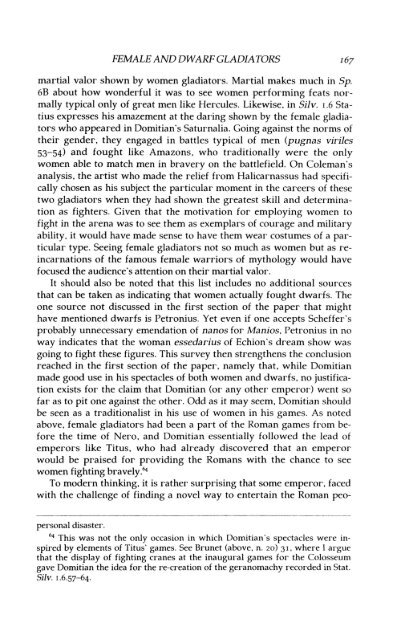OUSEION - Memorial University's Digital Archives Initiative ...
OUSEION - Memorial University's Digital Archives Initiative ...
OUSEION - Memorial University's Digital Archives Initiative ...
Create successful ePaper yourself
Turn your PDF publications into a flip-book with our unique Google optimized e-Paper software.
FEMALE AND DWARFGLADIATORS r67<br />
martial valor shown by women gladiators. Martial makes much in Sp.<br />
6B about how wonderful it was to see women performing feats normally<br />
typical only of great men like Hercules. Likewise. in Silv. 1.6 Statius<br />
expresses his amazement at the daring shown by the female gladiators<br />
who appeared in Domitian's Saturnalia. Going against the norms of<br />
their gender. they engaged in battles typical of men (pugnas viriles<br />
53-54) and fought like Amazons. who traditionally were the only<br />
women able to match men in bravery on the battlefield. On Coleman's<br />
analysis. the artist who made the relief from Halicarnassus had specifically<br />
chosen as his subject the particular moment in the careers of these<br />
two gladiators when they had shown the greatest skill and determination<br />
as fighters. Given that the motivation for employing women to<br />
fight in the arena was to see them as exemplars of courage and military<br />
ability. it would have made sense to have them wear costumes of a particular<br />
type. Seeing female gladiators not so much as women but as reincarnations<br />
of the famous female warriors of mythology would have<br />
focused the audience's attention on their martial valor.<br />
It should also be noted that this list includes no additional sources<br />
that can be taken as indicating that women actually fought dwarfs. The<br />
one source not discussed in the first section of the paper that might<br />
have mentioned dwarfs is Petronius. Yet even if one accepts Scheffer's<br />
probably unnecessary emendation of nanos for Manios. Petronius in no<br />
way indicates that the woman essedarius of Echion's dream show was<br />
going to fight these figures. This survey then strengthens the conclusion<br />
reached in the first section of the paper. namely that. while Domitian<br />
made good use in his spectacles of both women and dwarfs. no justification<br />
exists for the claim that Dornitian (or any other emperor) went so<br />
far as to pit one against the other. Odd as it may seem. Domitian should<br />
be seen as a traditionalist in his use of women in his games. As noted<br />
above. female gladiators had been a part of the Roman games from before<br />
the time of Nero. and Domitian essentially followed the lead of<br />
emperors like Titus. who had already discovered that an emperor<br />
would be praised for providing the Romans with the chance to see<br />
women fighting bravely.6 4<br />
To modern thinking. it is rather surprising that some emperor. faced<br />
with the challenge of finding a novel way to entertain the Roman peo-<br />
personal disaster.<br />
64 This was not the only occasion in which Domitian's spectacles were inspired<br />
by elements of Titus' games. See Brunet (above. n. 20) 31. where I argue<br />
that the display of fighting cranes at the inaugural games for the Colosseum<br />
gave Domitian the idea for the re-creation of the geranomachy recorded in Stat.<br />
Silv. 1.6.57-64.

















